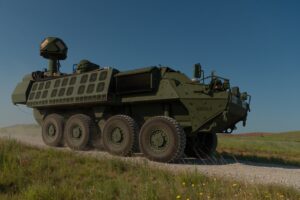Raytheon Technologies [RTX] is moving forward on the Army’s program to deliver four Stryker-mounted 50-kilowatt laser prototypes in late fiscal year 2022, service officials confirmed Wednesday, with Northrop Grumman
[NOC] having been dropped from the program before a shoot-off evaluation this summer.
Army officials would not confirm the specific reason Northrop Grumman exited as one of two competitors vying for the Directed Energy Maneuver Short-Range Air Defense (DE M-SHORAD) program, while noting the firm failed to meet a required gate criteria during a quarterly assessment.

“We reached a point where we had one team that cleared a gate and one team that did not clear the gate. And at that point, unfortunately, we had to eliminate the team that did not meet the requirements for that gate. So you still had Kord [Technologies] as the prime for the remaining team, but the team that had Northrop Grumman as the principle provider for the laser weapon system, that team did not meet the particular gate,” Col. G. Scott McLeod, the Army’s program manager for DE M-SHORAD, told reporters on Wednesday.
In August 2019, the Army announced it selected Kord Technologies to provide the 50 kilowatt laser for DE M-SHORAD, while Northrop Grumman and Raytheon would each integrate the laser module on a Stryker vehicle as competing prototypes (Defense Daily, Aug. 1 2019).
DE M-SHORAD is intended to deliver a on-the-move laser system capable of taking down unmanned aerial systems, rotary-wing aircraft and rockets, artillery and mortars, with plans to deliver a platoon of four laser-equipped Strykers by the fall of 2022.
The OTA award from 2019 included an option for the three additional prototypes, which has now been exercised with the Raytheon team following its participation in the July combat shoot-off (Defense Daily, Aug. 12).
Craig Robin, deputy director of the Army’s Rapid Capabilities and Critical Technologies Office’s directed energy project office, told reporters there is potential for the Raytheon team to build additional prototypes before DE M-SHORAD shifts to a program of record led by Program Executive Office-Missiles and Space.
“We will maintain production with the team that builds those first four [prototypes], and part of the reason for that is to ensure the industrial base is in place. Then we provide Army senior leaders with some decision space on how they want to proceed to a full program of record in the future. We have money in the budget and plans to continue to build a small number of prototypes and allow Army senior leaders the decision space for a competitive program of record in the future,” Robin said.
Robin said he expects PEO Missiles and Space is likely to conduct a full and open competition for the eventual DE M-SHORAD production contract.
“Of course, we’d always like to have more competitors. I think the solution set that we have right now with the team that is moving forward is providing the capability that the Army needs. So no real concerns there. The technology is mature enough to address the threats and that team showed that they can build the system to do that. We are confident and excited about moving forward with the new technology,” Robin said in response to a question on the prototyping program being narrowed down to a single competitor.